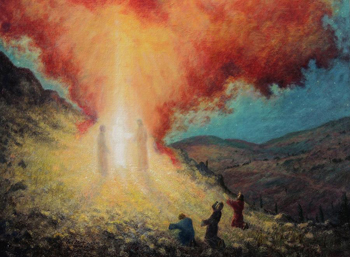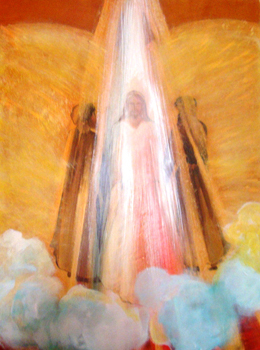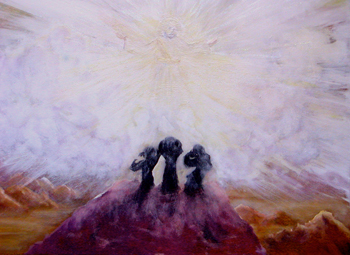For Sunday February 23, 2020
Lectionary Readings (Revised Common Lectionary, Year A)
Exodus 24:12-18
Psalm 2 or Psalm 99
2 Peter 1: 16-21
Matthew 17:1-9
It's Transfiguration Sunday — the apex of the liturgical season we call Epiphany. After weeks of hints and intimations — a star, a dove, a baptizer’s voice in the wilderness — today we emerge into full sunlight, blinded as God parts the veil and shows us Christ’s majesty.
All of the Synoptic Gospels tell the story of the Transfiguration, underscoring its importance to the early church, and over the centuries, the event has acccumulated meanings — most of them abstractly theological. Growing up, I was taught that the Transfiguration is important because it reveals Jesus’s divine nature, foreshadows his death, secures his place in the stream of Israel's salvific history, exalts him above the Law (Moses) and the Prophets (Elijah), and prefigures his Resurrection.
Weighty and important stuff, no doubt. But here’s my confession: I’m not sure I like the Transfiguration. I’m not sure it serves us well. Here’s why:
For as long as I can remember, I’ve measured the depth and “success” of my faith by the number of mountaintop experiences I can truthfully claim. Have I “felt the Spirit” in Sunday morning worship? Has Jesus “spoken” to me? Have I seen visions? Spoken in tongues? Encountered God’s living presence in my dreams?
Most of the time, the answer is “no.” Which means I’ve spent most of my life feeling like a spiritual failure. “Deep” and “mature” Christians (I’ve assumed), have frequent experiences akin to Peter’s on the mountaintop. They see visions and dream dreams. They have actual conversations with a God who speaks to them in audible English. Jesus reveals himself to them in spectacular ways they can’t describe or deny. They don't have to squint and strain to discern God's presence; God shows up in their living rooms in Technicolor glory, and blows their minds.
 |
It's not true, of course. This hierarchy of holiness. This way of measuring piety. And yet it lingers in me — this yearning for a particular kind of affective experience to come along on a regular basis, and validate my faith. The truth is, I like and want and crave and covet Christian mountaintops. And stories like the Transfiguration don't help. If Peter could see Jesus in his full, unfiltered glory, why can't I?
One of the many problems with my “God on the mountaintop” version of Christianity is that it prompts me to carve up and compartmentalize my life. To separate “sacred” from “secular.” The mountain from the valley. The spectacular from the mundane. As if God is somehow more present during a rousing worship set, a stirring sermon, or a silent retreat in a seaside monastery, than God is when I'm doing the laundry, returning a library book, or driving my son to his friend's house. The work of discernment is harder and messier in everyday life, yes. I have to look for God minus blinding lights and roaring thunder. But that doesn't mean it's impossible. The God of the whisper is still God.
In its worst iteration, mountaintop Christanity is addictive, such that we spend our days pursuing a “high” we conflate with spiritual success. When we don’t experience that high, we feel empty, unloved, angry, or bored. Meanwhile, we don't notice the ever-present God in whom we actually live and move and have our being. Desperate for the mountain, we miss the God of the valley, the conference room, the school yard, the grocery store, the street corner. Worshipping the extraordinary doesn’t make for a healthy faith.
In our Gospel reading this week, Peter responds to Jesus’s Transfiguration with an affirmation, immediately followed by a proposal: “Lord, it is good for us to be here.” “If you wish, I will make three dwellings.”
It is good for us to be here. Is it? Well, in some ways, yes. In some ways, Peter is absolutely right. It is good to set aside times and places for contemplation. It is good to gaze upon Jesus, whenever and however he reveals himself to us. It is good to move out of our comfort zones and confront the indescribable Otherness of the divine.
Until the Transfiguration happens, Peter and his fellow disciples experience Jesus as a teacher, a storyteller, a healer, and a traveling companion. His face, his manners, his voice, his mission — all are familiar to them. Familiar, endearing, and safe.
 |
Then one day, high up on a mountain, the unimaginable happens. Before their very eyes, Jesus changes, becoming at once both fully himself and fully unrecognizable. The man they think they know is suddenly more, suddenly Other. And the path that lies ahead of him — a path that must end on another high place, a hill called Golgotha — upends everything the disciples think they understand about Jesus.
Whenever we think we have God figured out, it’s good to be reminded that we’re wrong. Whenever we try to stuff Jesus into a theological, cultural, or political box for our own convenience, it’s good to have that box blown open. Whenever we grow complacent, self-righteous, or lazy in our lives of faith, it’s good to be brought to our knees by a God whose thoughts are not our thoughts, and whose ways are not our ways. There are very good reasons to encounter Jesus on the mountaintop.
On the other hand, it’s not good to fixate on the sublime so much that we desecrate the mundane. Most of life is unspectacular. By which I mean, most of life doesn’t dazzle us with non-stop special effects. But all of life — all of life — contains the sacred. The challenge is to cultivate the kind of sight that perceives God in places darker, murkier, and more obscure than a mountaintop.
As soon as Peter affirms his experience, he tries to hoard it. What I hear in his plan to “make dwellings” is an understandable but ultimately misguided attempt to contain, domesticate, protect, and possess the sublime. To harness the holy. To make the fleeting permanent. To keep Jesus shiny, beautiful, and safe up on a mountain. After all, everything is so good up there. So clear. So bright. So unmistakably spiritual. Why not stay forever?
Well, because God says no. Even before Peter is finished speaking, God covers him in a thick cloud, and tells him to listen to Jesus — NOT to his own misconceptions about the life of faith. It’s Jesus’s way — the way of the valley, the way of the cross, the way of humility, surrender, and sacrifice — that Peter must learn to follow.
In Matthew’s version of the Transfiguration event, the disciples are overcome with fear when God speaks to them out of the cloud. They cower in silence, and fall to the ground. But then comes the part of the story I do like: “Jesus came and touched them, saying, ‘Get up and do not be afraid.’ And when they looked up, they saw no one except Jesus himself alone.”
 |
Jesus comes and touches his friends, and in that simple, ordinary human encounter of skin on skin, the disciples catch their breath, shed their fear, and return to themselves. Finally, they see the divine in a guise they can bear. As it turns out, Peter, for all his eagerness and bluster, isn’t made for unending Transfigurations. He can’t handle too much of the spectacular. All he can actually take of God’s glory is a tender human hand on his shoulder, and a reassuringly human voice in his ear.
Here’s the thing: I still yearn for mountaintop experiences, and that’s okay. They’ll come and go according to God’s will and timing, not according to my micromanagement. In that sense, sublime spiritual experiences are easy; they require little from me. I can’t control them. What’s hard is consenting to follow Jesus back down the mountain. What’s challenging is learning to cultivate awe and wonder in the face of the mundane. What’s essential is finding Jesus in the rhythms and routines of the everyday. In the loving touch of a friend. In the human voices that say, “Don’t be afraid.” In the unspectacular business of discipleship, prayer, service, and solitude. In the unending challenge to love my neighbor as myself.
With Transfiguration Sunday, we come to the end of another liturgical season. Having seen the bright lights of Epiphany, we prepare now for the long darkness of Lent. We can’t know ahead of time what mountains and valleys lie ahead. We can’t predict how God will speak, and in what guise Jesus might appear. But we can trust in this: whether on the brightest mountain, or in the darkest valley, Jesus abides. Even as he blazes with holy light, his hand remains warm and solid on our shoulders. Even when we're on our knees in the wilderness, he whispers, “Do not be afraid.”
So listen to the ordinary. Keep listening. It is good for us to be here.
Debie Thomas: debie.thomas1@gmail.com
Image credits: (1) Fine Art America; (2) Bloor Lansdowne Christian Fellowship; and (3) Linnie Aikens Arts and Letters.





